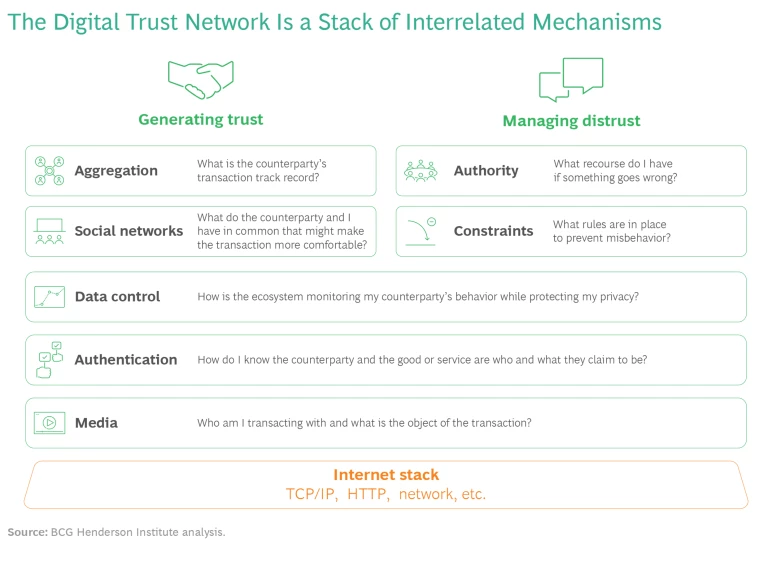From Amazon to LinkedIn to Uber, digital business ecosystems have increasingly become mainstays of daily life. What makes these ecosystems so appealing is that they enable total strangers to transact with one another quite frictionlessly. But doing so rests on a critical linchpin—trust.
Whether you are an ecosystem orchestrator or contributor, digital trust can create flywheel effects that also, of course, benefit users. According to our research , 86% of successful ecosystems have actively embedded trust in their platforms and operating models. The absence of trust, however, can cause significant friction: in more than half of the ecosystems that failed, trust played a critical role in their demise. At a time when trust in many of our institutions is suffering, and online interactions and transactions are increasingly supplanting physical ones, it’s incumbent on businesses—and ecosystems in particular—to treat trust as a strategic priority.
It’s incumbent on businesses—and ecosystems in particular—to treat trust as a strategic priority.
But while it’s easy to recognize the need for trust, it’s more difficult for leaders to understand how to embed it in their ecosystems. Trust is complex. And a vast and growing array of technologies that claim to tackle trust at scale compound that difficulty.
To help leaders overcome these roadblocks and reinforce end-to-end trust among their users, we’ve developed an organizing framework for building a robust digital trust network (DTN). This framework represents the layers of integrated mechanisms and tools that enable secure and trusted transactions and interactions among members and users. With the DTN framework, ecosystem leaders can stress test their trust architecture, identifying gaps, solidifying weak points, and instituting adjustments that can engender and strengthen trust, without getting mired in the minutiae of technological tools.
The Trust Stack
Our DTN framework breaks trust into seven layers, providing leaders with a methodical approach to addressing and understanding the complex concept of trust. (See the exhibit.) Similar to the structure of a tech stack, the seven layers are networked and build on one another, with the bottom layers supporting the top ones. No single layer can solve for trust: it is end-to-end trustworthiness that matters to users, and that can be achieved only through a comprehensive trust architecture. (Blockchain, often touted as a silver bullet for establishing trust, cannot foster end-to-end trust.) By selecting tools and tactics—which can be digital or analog—to address each of the seven layers, leaders can ensure that trust is systematically engineered throughout their ecosystem, allowing users to seamlessly and easily transact and interrelate.

We describe the layers in the form of questions from a user’s perspective. Then, to illustrate how the layers work together, we draw on Airbnb’s own integrated approach, which perfectly reflects the comprehensive DTN architecture and its seven mechanisms.
Seeding Trust, Controlling Distrust
The three base layers—media, authentication, and data control—do double duty, enabling mechanisms that both generate trust and manage distrust.
Media. “Who am I transacting with and what is the purpose of the transaction?” Media consists of emails, text messages, voice, photos, or video (or some combination thereof) and promotes trust by creating digital representations of each counterparty, the object of the transaction, or both. The closer the digital representation is to physical reality, the more trust it engenders.
At Airbnb, hosts and guests see the same type of profile that includes their first name with a photo, the date they joined the platform, and their bio. Property profiles include photos of rooms, descriptions of amenities, reviews from previous customers, and a high-level location.
Authentication. “How do I know the counterparty and the good or service are who and what they claim to be?” Authentication deals with confirming counterparties’ identities and verifying that the transaction object is genuine—both elements typically represented in the media layer. Authentication can take many forms, digital and analog, such as facial recognition, two-factor sign-ins, and in-person inspection of goods and services.
Airbnb uses phone and email verification (via self-confirmation texts and email messages) and identity verification (via third parties or government-issued documents) to confirm the data presented in the media layer. The system also runs checks on hosts and guests using watch lists. In some regions, it conducts background checks and onsite property inspections.
Data Control. “How is the ecosystem monitoring my counterparty’s behavior while protecting my privacy?” Data control involves managing counterparties’ access to data about one another, such as through sharing GPS tracking information or using a blockchain to record transactions. Making this data irrevocable—through, for instance, a trusted intermediary or tools such as a blockchain—is essential for mitigating disputes among users.
Airbnb releases exact location and contact information (already verified in the authentication layer) only after a reservation has been confirmed. In addition, hosts and users submit their payment information to the platform, not to one another directly.
The Trust Generators
Two layers serve to actively engender trust.
Social Networks. “What do the counterparty and I have in common that might make the transaction more comfortable?” Social networks help to unveil commonalities among users—mutual contacts, shared interests—thus making people less apprehensive about engaging with a stranger. To foster social networking, an ecosystem orchestrator can offer user-to-user messaging, facilitate user meetups, or allow users to link their social media accounts to their profiles (described in the media layer).
Social networks help to unveil commonalities among users—mutual contacts, shared interests—thus making people less apprehensive about engaging with a stranger.
Airbnb offers hosts a global community center where they can share knowledge and meet one another. In addition, users can include links to their social media accounts on the profiles described in the media layer.
Aggregation. “What is the counterparty's transaction track record?” Aggregation involves collecting and synthesizing large samples of data about a user’s prior transactions. It essentially superimposes the game theory concepts of the “shadow of the past” (a user’s track record) on the “shadow of the future” (the idea that individuals change their behavior when they anticipate multiple future interactions with a counterparty). Because users know that their track record will be shared with all future potential users, they are more likely to act cooperatively.
Aggregation mechanisms include generating an average rating for users, publicly labeling high-performing users, and sharing relevant data such as on-time shipping rates and reply speeds. The information shared in this layer depends on the data control strategy that the orchestrator uses.
Airbnb provides an aggregated score for each listed property and displays all reviews received by guests and hosts on the profiles described in the media layer. Hosts who meet Airbnb’s criteria for excellent service are listed as “superhosts” on their profiles.
The Distrust “Managers”
Two layers serve to manage and mitigate distrust.
Constraints. “What rules are in place to prevent misbehavior?” Constraints, which encompass rules, procedures, and protocols, limit misbehavior. Constraint mechanisms include automatically limiting wait times, restricting transactions that meet fraud criteria, requiring upfront deposits for services, setting fixed prices, and many others. Rather than actively fostering trust, constraints eliminate the need for trust; that is, they serve as a “substitute for trust” by restricting certain behavior without relying on trust.
A key constraint at Airbnb is providing escrow: holding payments to hosts until guests have safely checked in, according to the indirect payment policy described in the data control layer. Another is restricting guests and hosts from seeing one another’s post-stay review until both parties are done reviewing or after a set period. A third constraint prevents users from altering their reviews once posted, a measure that reduces the risk of retaliatory reviewing.
When designing constraints, it’s important to pursue a balanced approach. Onerous measures can create bottlenecks and stifle ecosystem use; conversely, overly lenient mechanisms can result in inadequate protection for users.
Authority. “What recourse do I have if something goes wrong?” Authority comprises the set of rewards and punishments an ecosystem establishes to encourage good behavior and discourage bad behavior. Instead of enhancing trust between counterparties, authority builds users’ trust in the ecosystem itself. It can be imposed either by the ecosystem orchestrator or by a third party, such as a court of law. Examples of authority mechanisms include suspending users from participation after infractions, removing inappropriate written content from online message boards, and rewarding good behavior by giving perquisites to top-performing users.
Airbnb suspends hosts who fail to meet requirements such as maintaining high ratings, a failure whose risk is precluded by constraint mechanisms. The company also retains the right to ban a user without explanation.
Keeping Trust Alive
For companies that do it right, trust not only reduces friction but fuels higher user engagement, accelerated network effects, and growth. Airbnb’s approach to embedding trust across the seven DTN layers has been instrumental to its success in transforming a risky proposition—renting out one’s home to a stranger or paying to stay at a stranger’s home—into a multibillion-dollar business. Other successful ecosystems (such as Amazon, DeBeers, Etsy, IBM [IBM Food Trust], Instacart, Kickstarter, Maersk, and Upwork) have also built robust DTN architectures that are tailored to their business models and use a wide array of tools, including live GPS tracking, badges for top-performing sellers, and blockchain technology .
Successful ecosystems demonstrate that leaders can’t just build their businesses and hope that trust will spontaneously emerge. To scale and grow, it’s critical to intentionally and proactively design trust into the business and regularly monitor and adapt the mechanisms as participants and behaviors change and as new enabling technologies emerge. The DTN framework provides a clear, objective means for reassessing and, if need be, redesigning an ecosystem’s existing trust architecture. For new ecosystems, it can serve as a checklist to guide the design of its trust architecture. With this framework, leaders can develop and bolster sustainable trust, unlocking immense value—along with competitive advantage.












